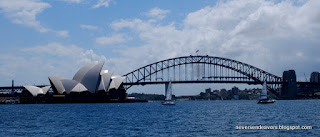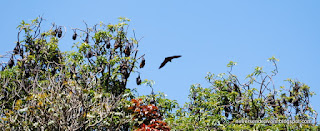 Eels and bats...oh my...am I in Transylvania? Nope. I am in downtown Sydney.
Eels and bats...oh my...am I in Transylvania? Nope. I am in downtown Sydney. Some of the best views of the Sydney icons are offered from the public gardens. The Sydney Royal Botanic Gardens is part of the original garden called the Governor's Domain.
Some of the best views of the Sydney icons are offered from the public gardens. The Sydney Royal Botanic Gardens is part of the original garden called the Governor's Domain. In 1816, the land was set aside by the Governor of Sydney, Governor Macquarie. The huge number of things in Australia named Macquarie is a testimony to his governing (or his vanity). One spot in the park is named Mrs. Macquarie's Seat. She liked to sit, look out at the harbour, and watch the ships coming and going. Since he was Governor, he had a road built through the Domain just for her to get there. The seat is carved out of stone. It's good to be The Governor.
 Just above this spot is one of the most photographed spots in all of Sydney (you would never know it because it is where people stand).
Just above this spot is one of the most photographed spots in all of Sydney (you would never know it because it is where people stand). The viewpoint looks back on the Opera House with the Harbour Bridge backdrop. It is the PERFECT place to watch fireworks on New Years (if you can get there early enough). I did exactly that in 2001 when Australia celebrated its Centennial of becoming the commonwealth. It was an amazing spot but by noon, the place was packed.
The park is beautiful. It has expanded since the original Domain and now is over 30 hectares. Throughout most of the park you can see the skyscrapers of downtown Sydney just behind the trees.
 The gardens can be accessed from several entrances including an easy walk from Circular Quay around the Sydney Opera House. It is open until around dusk and is free to enter. They even have daily free hour long walking tours. The tours are different depending on the guide, but most of the volunteers conducting the tour are quite good.
The gardens can be accessed from several entrances including an easy walk from Circular Quay around the Sydney Opera House. It is open until around dusk and is free to enter. They even have daily free hour long walking tours. The tours are different depending on the guide, but most of the volunteers conducting the tour are quite good. The plants include an herb garden, rose garden, palm house, Chinese garden, and natural indigenous plants. Every tour makes a point to stop at the Wollemi Pine. It is one of the world's oldest and rarest tree species belonging to a 200 million-year-old plant family. It had only been seen in the fossil record and was thought to be extinct. A grove of them were discovered in the mid 1990's by a botanist bushwalking in the Blue Mountains west of Sydney. Several specimens have been sent to protected parks to help ensure the survival of the species.
The plants include an herb garden, rose garden, palm house, Chinese garden, and natural indigenous plants. Every tour makes a point to stop at the Wollemi Pine. It is one of the world's oldest and rarest tree species belonging to a 200 million-year-old plant family. It had only been seen in the fossil record and was thought to be extinct. A grove of them were discovered in the mid 1990's by a botanist bushwalking in the Blue Mountains west of Sydney. Several specimens have been sent to protected parks to help ensure the survival of the species. Among the most stunning sights are the Jacaranda trees in full bloom. The purple was so beautiful and vibrant. The other show-off is the yellow wattle. The yellow poof balls are all over the tree (pictured above).
Among the most stunning sights are the Jacaranda trees in full bloom. The purple was so beautiful and vibrant. The other show-off is the yellow wattle. The yellow poof balls are all over the tree (pictured above).
The tall, proud Norfolk Pines are also scattered through the park. These trees were imported from Norfolk Island (a Pacific island east of Australia, between New Caledonia and New Zealand). Captain Cook thought that the trees would make excellent ship masts, as their trunks are so straight and tall. This was not the case but their distinctive features are great for marking harbour entrances. They are scattered throughout the South Pacific.
I love the Queensland Bottle Tree. There is an aboriginal story about the tree. The legend goes that the tree was a beautiful tree, but was vain. The tree would flaunt its beauty to all of the other trees around. The gods warned the tree to stop. The tree ignored the warnings. So the gods came down and uprooted the tree, turned it upside down. The bottle tree has remained with all of its roots in the air.

 The gardens are full of animals. Sulfur-Crested Cockatoos are found in droves. They crunch on seeds and nuts. And they are LOUD. You hear a flock of cockatoos before you can see them. They are constantly screeching at each other and jostling. It is a lot of fun to see them display their crest of yellow head feathers.
The gardens are full of animals. Sulfur-Crested Cockatoos are found in droves. They crunch on seeds and nuts. And they are LOUD. You hear a flock of cockatoos before you can see them. They are constantly screeching at each other and jostling. It is a lot of fun to see them display their crest of yellow head feathers.The other bird frequently seen in the garden is the Australian White Ibis. The ibis are strange looking birds. They have long, thin, curved beaks. They are much quieter than their compatriots but also can be cheeky.
 One of my favorite discoveries was the ponds with ducks and eels. We were told that the ponds are emptied out occasionally for cleaning. The eels are removed and relocated. The park workers have seen new eels slithering across the grass from the harbour back to the pond. Yep, they can actually move across land to get to their desired destination. Fascinating. I laughed at the plaque beside the pond that describes how natural it is for a cuddly duckling to become an eel meal.
One of my favorite discoveries was the ponds with ducks and eels. We were told that the ponds are emptied out occasionally for cleaning. The eels are removed and relocated. The park workers have seen new eels slithering across the grass from the harbour back to the pond. Yep, they can actually move across land to get to their desired destination. Fascinating. I laughed at the plaque beside the pond that describes how natural it is for a cuddly duckling to become an eel meal.
It is strange to think of bats in a park in a major city. There are hundreds of fruit bats (or flying foxes) in the trees. Unfortunately, they are damaging the trees since they are not leaving for their normal migration. So the trees never recover. I guess they have decided that they like the views from the garden as well.
The sandstone in the park has been carved out over time creating beautiful spots to sit. The Sydney Royal Botanic Garden is a great place to read quietly, go for a walk, or picnic with friends.
It is a favorite Sydney destination and a must see when visiting..



Wow. As Master Yoda would put it: beautiful plants, these ase.
ReplyDelete